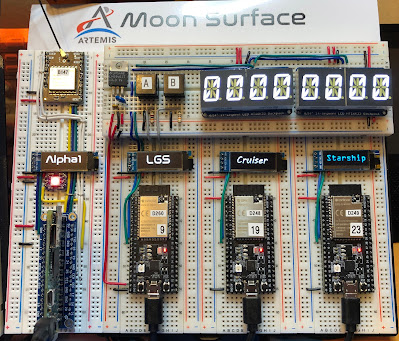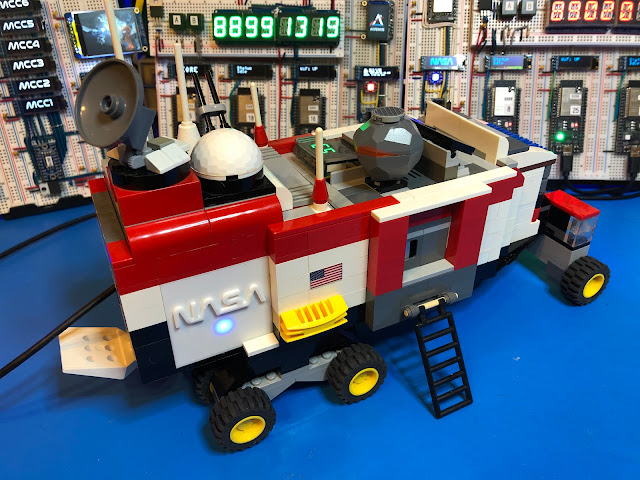 |
| Image Courtesy of NASA |
Since my early days tinkering with electronics, I always believed that one of the best ways of learning is by doing, getting your hands busy. My Mom (RIP) probably didn’t appreciate me taking appliances apart but over my long career in electronics, computer science and networking, I learned a lot by doing, and of course, reading any related materials, and during the past few years taking online classes.
I’m a byproduct of the Apollo era, I grew up fascinated with the space program, and my eyes were glued to our black and white TV when in 1969 Neil Armstrong set foot on the Moon. Yes, I dreamed about becoming an astronaut someday, but more than that, it cemented my inspiration to have a career in technology.
But this article is not about me, you can find more about me here.
Being a Pioneer Member of Internet Society (ISOC,) and my interest in learning more about space communications, during 2021 I joined ISOC’s Inter Planetary Networking Special Interest Group (IPNSIG.)
After some exchanges with Vint Cerf, watching his TEDx presentation from 10 years ago about his vision and work on an Interplanetary Internet, participating in several remote conferences and webinars, reading a lot about it, and researching the evolution of new technologies for Delay-Tolerant Networking (DTN – RFC4838) and Bundle Protocols (RFC5050,) it got me thinking:
“What can I do to learn more and share what I learn about these new evolving technologies?” …
I came up with:
“How about a low cost platform where we can tinker, experiment and do some development about objects communicating using DTN?” …
One interesting fact about DTN is that it not only provides a way for networking in space, there are other applications that can take advantage of it, like IoT, battlefield communications, and many other scenarios where communications could be disrupted or delayed for various reasons .
While this is something that have been on the works for some time, it is still nascent technology, with lots of space for learning and experimenting, huge commercial and STEM educational opportunities, etc. NASA is already using it on an experimental basis for its Interplanetary Overlay Network (ION.)
Based on my previous experience developing embedded systems with microcontrollers and single board computers (SBC,) and inspired by NASA’s Artemis Mission to get back to the Moon, I started putting together what I call the IPN DTN Lab Protoype.
 |
| IPN DTN R&D Lab Prototype |
The IPN DTN Lab is a collection of various SBCs (Raspberry Pi Zero W2) and ESP32-S2 Dev Kits, combined with different type of displays, a couple low power LoRa transceivers, a simple GPS receiver, etc. The idea is that the platform can be used also to learn how to interface different type of devices to each of the boards, and how to use DTN and Bundle protocols to exchange data between them.
This is very much work in progress, I just finished to put together the first complete version of the hardware with some basic code running on each of the boards, which for now are all communicating via WiFi with TCP/IP, few of them include a LoRa transceiver module for low rate and long range wireless communication.
As said before, the design is inspired on the Artemis Mission, then there are three sections, one includes various nodes representing different facilities on Earth, such as NASA’s Mission Control Center (MCC,) NASA’s Deep Space Network (DSN,) NASA’s Tracking and Data Relay Satellite network (TDRS,) etc. Also, ESA’s European Space Operations Center (ESOC,) and SpaceX CORE (Crew Operations and Resource Engineering.)
 |
| IPN DTN Lab - Earth Section |
The second section represents various object that will be in Moon’s Orbit, like NASA’s multi-purpose orbital outpost Gateway, ESA’s I-Hab expansion module for Gateway, NASA’s Orion Capsule, etc. |
| IPN DTN Lab - Moon Orbit Section |
And the third section represents various objects that will be in the Moon’s surface, such as NASA’s Lunar Ground Station (LGS,) SpaceX’s Starship Moon Lander, and JAXA’s pressurized Lunar rover being developed with Toyota aka Cruiser.
 |
| IPN DTN Lab - Moon Surface Section |
All the nodes feature a small 128x32 pixels OLED display, some of them include also a pair of four-digit alphanumeric LED display, and at least one RGB LED (NeoPixel.) On this version, five of the nodes are implemented with Raspberry Pi Zero W2 boards, three of them include a low power LoRa transceiver for long distance wireless communications. One of the Raspberry Pi Zero W2 boards is interfaced with a small GPS receiver module with the option for an external antenna for better reception.
The role of each node can be changed just by software. For example, this is one of the Raspberry Pi’s getting GPS data from another node via the network.
 |
| IPN DTN Lab - MCC node screen capture |
The design is completely scalable, and more nodes can be added to expand the network.
As said before this is very much work in progress. Being now the hardware development phase stable, I will be focusing on the software, bringing up the Bundle Protocols for communication, some demonstrations and documentation.
When people ask when it will be all ready, I always use the classic response from Elon’s Musk … “Two Weeks” 😊
I’m in the process of putting together several presentations and classes, a summary paper, various videos, etc.
I will be providing more details, and regular reports how the project progresses in future posts, stay tuned.
If you are interested to learn more about this, feel free to contact me, if you have ideas or constructive feedback feel free to leave a comment.
If you are interested in providing funding for projects like this, definitely contact me !!
Signing off for now from planet Earth
Cheers
Jorge




































